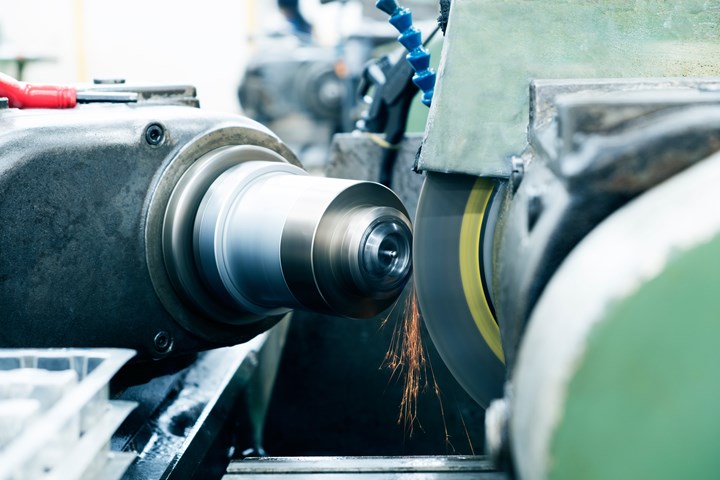Grinding Wheel Safety: Respect The Maximum Speed
One potential source of serious injury in grinding comes from an oversight that is easy to make: operating the wheel in an over-speed condition.
Share



.png;maxWidth=45)
DMG MORI - Cincinnati
Featured Content
View More
Takumi USA
Featured Content
View More

ECi Software Solutions, Inc.
Featured Content
View More

Hwacheon Machinery America, Inc.
Featured Content
View More
Autodesk, Inc.
Featured Content
View More

One potential source of serious injury in grinding comes from an oversight that is easy to make: operating the wheel in an over-speed condition. While a wheel that is run far enough in excess of its rated maximum speed may shatter within minutes of operation, danger may also result from a wheel run just slightly faster than its rated speed. This less severe over-speed condition can cause the wheel to be damaged, and the damage may result in breakage after further use. For example, operating a reinforced, 9-inch diameter, Type 27 wheel rated for a maximum speed of 6,600 rpm on a 7-inch angle grinder with a speed of 7,700 rpm can cause the wheel to crack. This cracking can lead to breakage later.
What other actions lead to an over-speed condition?
The following actions—all of which are not recommended—can also lead to an over-speed condition:
- Mounting the grinding wheel on a sander, such as a “pistol grip” air sander
- Mounting the wheel directly on an electric motor
- Mounting the wheel on the wrong machine size for that wheel
- Failing to properly maintain machine components, particularly governors on pneumatic machines and linkages on floorstand machines
- Using the incorrect air, hydraulic or electric power supply
- Using an improper speed setting on the machine
Any of these actions sets up a disastrous scenario that could lead to an accident involving serious injury or death.
The hazard of running in an over-speed condition comes from centrifugal force. A result of rotary motion, centrifugal force is what causes a weight on the end of a string to pull the string taught when the weight is swung in a circle. This same force causes the mass of the grinding wheel to be pulled outward from the center of rotation as the wheel is spinning.
Danger comes from the fact that centrifugal force does not increase in direct proportion to an increase in speed, but instead it increases as the square of that speed increase. When rotational speed doubles, centrifugal force quadruples. This effect means that relatively small changes in speed can produce significant increases in force. In the example mentioned, changing from 6,600 rpm to 7,700 rpm multiplies the speed by 1.167. However, the corresponding centrifugal force would multiply by a factor of 1.167 × 1.167, or 1.36.
To take a more extreme example, consider the same wheel with a maximum safe operating speed of 6,600 rpm run on a 5-inch right angle grinder at 10,000 rpm. This represents an over-speed of about 1.5 times the wheel’s designed speed. But the corresponding centrifugal force—and the corresponding rotational stress on the wheel—would be about 2.3 times as much as the maximum allowed.
In short, never over-speed a grinding wheel. The speed of the grinder must be compared to the speed marked on the wheel or package to make sure the machine’s speed is at or below the maximum operating speed of the wheel. Surpassing this rating risks not just wheel breakage but also the safety of shop personnel.
About the Author
Roger Cloutier is a senior product safety engineer for the Norton Abrasives brand of Saint-Gobain Abrasives in Worchester, Massachusetts.
Related Content
The Future of High Feed Milling in Modern Manufacturing
Achieve higher metal removal rates and enhanced predictability with ISCAR’s advanced high-feed milling tools — optimized for today’s competitive global market.
Read More6 Machine Shop Essentials to Stay Competitive
If you want to streamline production and be competitive in the industry, you will need far more than a standard three-axis CNC mill or two-axis CNC lathe and a few measuring tools.
Read MoreBallbar Testing Benefits Low-Volume Manufacturing
Thanks to ballbar testing with a Renishaw QC20-W, the Autodesk Technology Centers now have more confidence in their machine tools.
Read MoreOrthopedic Event Discusses Manufacturing Strategies
At the seminar, representatives from multiple companies discussed strategies for making orthopedic devices accurately and efficiently.
Read MoreRead Next
Choosing The Right Grinding Wheel
Understanding grinding wheel fundamentals will help you choose the right wheel for the job.
Read MoreRegistration Now Open for the Precision Machining Technology Show (PMTS) 2025
The precision machining industry’s premier event returns to Cleveland, OH, April 1-3.
Read More5 Rules of Thumb for Buying CNC Machine Tools
Use these tips to carefully plan your machine tool purchases and to avoid regretting your decision later.
Read More




.png;maxWidth=150)




























.jpg;maxWidth=300;quality=90)











